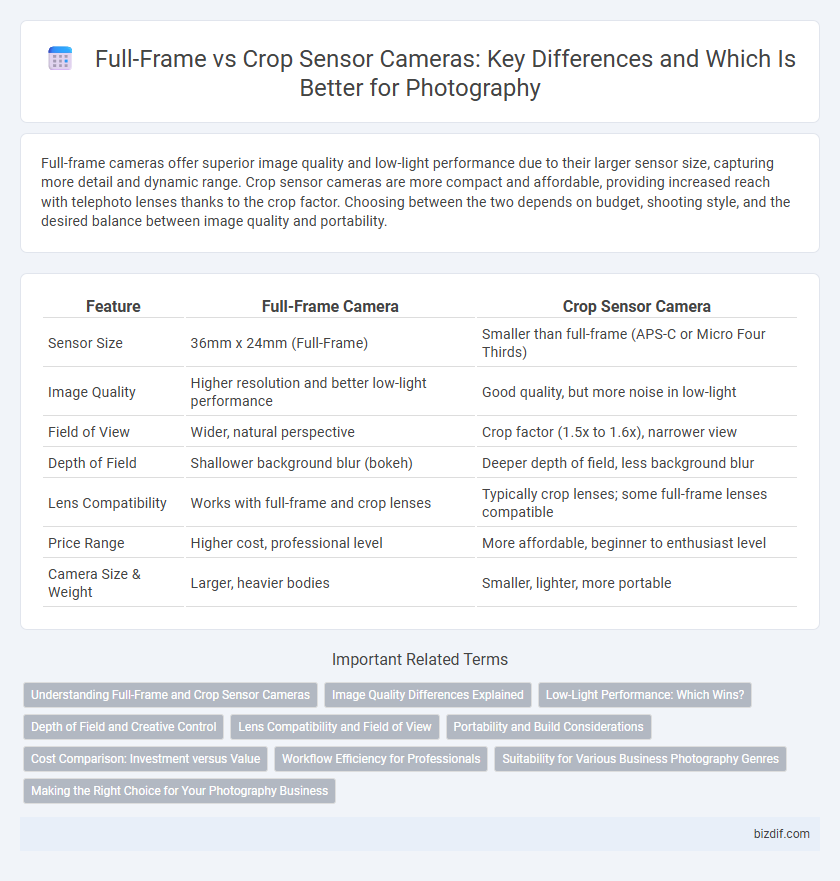Full-frame cameras offer superior image quality and low-light performance due to their larger sensor size, capturing more detail and dynamic range. Crop sensor cameras are more compact and affordable, providing increased reach with telephoto lenses thanks to the crop factor. Choosing between the two depends on budget, shooting style, and the desired balance between image quality and portability.
Table of Comparison
| Feature | Full-Frame Camera | Crop Sensor Camera |
|---|---|---|
| Sensor Size | 36mm x 24mm (Full-Frame) | Smaller than full-frame (APS-C or Micro Four Thirds) |
| Image Quality | Higher resolution and better low-light performance | Good quality, but more noise in low-light |
| Field of View | Wider, natural perspective | Crop factor (1.5x to 1.6x), narrower view |
| Depth of Field | Shallower background blur (bokeh) | Deeper depth of field, less background blur |
| Lens Compatibility | Works with full-frame and crop lenses | Typically crop lenses; some full-frame lenses compatible |
| Price Range | Higher cost, professional level | More affordable, beginner to enthusiast level |
| Camera Size & Weight | Larger, heavier bodies | Smaller, lighter, more portable |
Understanding Full-Frame and Crop Sensor Cameras
Full-frame cameras feature sensors equivalent in size to 35mm film, offering superior image quality, better low-light performance, and wider dynamic range compared to crop sensor cameras. Crop sensor cameras have smaller sensors, typically APS-C or Micro Four Thirds, resulting in a crop factor that narrows the field of view and enhances perceived telephoto reach. Choosing between full-frame and crop sensor depends on factors such as budget, intended use, and desired depth of field effects in photography.
Image Quality Differences Explained
Full-frame cameras feature larger sensors, capturing more light and delivering superior image quality with enhanced dynamic range and low-light performance compared to crop sensor cameras. The increased sensor size results in higher resolution, better color depth, and reduced noise levels, making full-frame ideal for professional photography. Crop sensor cameras, while more affordable and compact, often exhibit increased noise and limited dynamic range, affecting overall image detail and clarity.
Low-Light Performance: Which Wins?
Full-frame cameras excel in low-light performance due to their larger sensor size, which captures more light, resulting in cleaner images with less noise at high ISO settings. Crop sensor cameras struggle in dim conditions because smaller sensors collect less light, often requiring higher ISO that introduces grain. For photographers prioritizing superior low-light quality, full-frame models consistently outperform crop sensor counterparts.
Depth of Field and Creative Control
Full-frame cameras provide a shallower depth of field compared to crop sensor cameras, enabling photographers to achieve more pronounced background blur and subject isolation for creative portraits and artistic compositions. The larger sensor size in full-frame models captures more light, enhancing low-light performance and dynamic range, which expands creative control over exposure and detail. Crop sensor cameras, while offering increased effective focal length, tend to produce deeper depth of field, limiting background separation but allowing greater sharpness across the frame, advantageous in landscape and macro photography.
Lens Compatibility and Field of View
Full-frame cameras provide a wider field of view compared to crop sensor cameras due to their larger sensor size, allowing lenses to capture more scene area without focal length adjustment. Lenses designed for full-frame sensors maintain their intended focal lengths and image quality when used on crop sensor bodies, though the field of view narrows by the crop factor, typically 1.5x or 1.6x. Crop sensor cameras can use both APS-C and full-frame lenses, but full-frame lenses may result in increased size and weight, impacting portability and handling.
Portability and Build Considerations
Full-frame cameras generally have larger bodies and heavier construction due to bigger sensors and robust weather sealing, which can impact portability for photographers on the move. Crop sensor cameras offer more compact and lightweight designs, making them ideal for travel and extended handheld shooting without causing fatigue. Choosing between these systems depends on balancing the need for durability against convenience in carrying gear.
Cost Comparison: Investment versus Value
Full-frame cameras typically have higher upfront costs compared to crop sensor cameras, reflecting advanced sensor technology and superior image quality. Crop sensor cameras offer a more budget-friendly investment, making them ideal for amateur photographers or those prioritizing portability without sacrificing decent image performance. The value proposition depends on the photographer's needs, where full-frame systems deliver professional-grade results justifying the expense, while crop sensors provide accessible quality and versatility at a lower price point.
Workflow Efficiency for Professionals
Full-frame cameras offer superior image quality and low-light performance, reducing the need for extensive post-processing and streamlining professional workflows. Crop sensor cameras provide benefits like increased effective focal length and lighter gear, aiding speed during shoots but sometimes requiring more editing to compensate for noise and detail loss. Choosing between the two impacts workflow efficiency through balancing shooting flexibility, image quality, and editing time.
Suitability for Various Business Photography Genres
Full-frame cameras deliver superior image quality and low-light performance, making them ideal for high-end commercial, fashion, and architectural photography where detail and dynamic range are critical. Crop sensor cameras offer greater reach with telephoto lenses, benefiting wildlife, sports, and event photographers who need to capture distant subjects efficiently. Businesses prioritizing budget and portability often choose crop sensors for product and real estate photography, balancing cost with professional output.
Making the Right Choice for Your Photography Business
Choosing between a full-frame camera and a crop sensor camera significantly impacts image quality, depth of field, and low-light performance in your photography business. Full-frame cameras typically offer superior dynamic range and better noise control, essential for professional portraits and commercial shoots, while crop sensor cameras provide a cost-effective solution with increased telephoto reach, beneficial for wildlife and sports photography. Prioritizing your photography niche and budget will guide you to the optimal sensor choice that enhances your creative output and meets client expectations.
Full-Frame Camera vs Crop Sensor Camera Infographic

 bizdif.com
bizdif.com